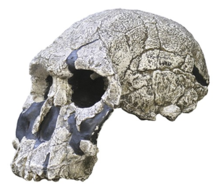
Back Homo rudolfensis Afrikaans إنسان بحيرة رودولف Arabic Homo rudolfensis AST Homo rudolfensis Azerbaijani رودولف اینسانی AZB Homo rudolfensis Byelorussian Homo rudolfensis Bulgarian Homo rudolfensis Catalan Homo rudolfensis Czech Homo rudolfensis Welsh
| Homo rudolfensis Temporal range: Pleistocene,
| |
|---|---|

| |
| Reconstruction of the KNM-ER 1470 skull | |
| Scientific classification | |
| Domain: | Eukaryota |
| Kingdom: | Animalia |
| Phylum: | Chordata |
| Class: | Mammalia |
| Order: | Primates |
| Suborder: | Haplorhini |
| Infraorder: | Simiiformes |
| Family: | Hominidae |
| Subfamily: | Homininae |
| Tribe: | Hominini |
| Genus: | Homo (?) |
| Species: | †H. rudolfensis
|
| Binomial name | |
| †Homo rudolfensis (Alekseyev, 1986)
| |
| Synonyms | |
| |
Homo rudolfensis is an extinct species of archaic human from the Early Pleistocene of East Africa about 2 million years ago (mya). Because H. rudolfensis coexisted with several other hominins, it is debated what specimens can be confidently assigned to this species beyond the lectotype skull KNM-ER 1470 and other partial skull aspects. No bodily remains are definitively assigned to H. rudolfensis. Consequently, both its generic classification and validity are debated without any wide consensus, with some recommending the species to actually belong to the genus Australopithecus as A. rudolfensis or Kenyanthropus as K. rudolfensis, or that it is synonymous with the contemporaneous and anatomically similar H. habilis.
H. rudolfensis is distinguished from H. habilis by larger size, but it is also argued that this species actually consists of male H. habilis specimens, assuming that H. habilis was sexually dimorphic and males were much larger than females. Because no bodily remains are definitely identified, body size estimates are largely based on the stature of H. habilis. Using this, male H. rudolfensis may have averaged about 160 cm (5 ft 3 in) in height and 60 kg (130 lb) in weight, and females 150 cm (4 ft 11 in) and 51 kg (112 lb). KNM-ER 1470 had a brain volume of about 750 cc (46 cu in). Like other early Homo, H. rudolfensis had large cheek teeth and thick enamel.
Early Homo species exhibit marked brain growth compared to Australopithecus predecessors, which is typically explained as a change in diet with a calorie-rich food source, namely meat. Though not associated with tools, dental anatomy suggests some processing of plant or meat fiber before consumption, though the mouth could still effectively chew through mechanically challenging food, indicating tool use did not greatly affect diet.
−10 — – −9 — – −8 — – −7 — – −6 — – −5 — – −4 — – −3 — – −2 — – −1 — – 0 — |
| |||||||||||||||||||||||||||||
© MMXXIII Rich X Search. We shall prevail. All rights reserved. Rich X Search